Physico-Mechanical Properties of Waterlogged Archaeological Wood: The Case of a Charred Medieval Shipwreck
Abstract
1. Introduction
2. Materials and Methods
2.1. Morphological Alterations at a Cellular Level
Scanning Electron Microscopy (SEM)
2.2. Physical Properties
2.2.1. Moisture Content, Density and Shrinkage Determination
2.2.2. Mercury Intrusion Porosimetry (MIP)
2.3. Mechanical Properties
2.3.1. Janka Hardness Test
2.3.2. Penetrometer
3. Results and Discussion
3.1. Morphological Alterations at a Cellular Level
Scanning Electron Microscopy (SEM)
3.2. Physical Properties
3.2.1. Moisture Content, Density and Shrinkage Determination
3.2.2. Mercury Intrusion Porosimetry (MIP)
3.3. Mechanical Properties
3.3.1. Janka Hardness Test
3.3.2. Penetrometer
4. Conclusions
Author Contributions
Funding
Institutional Review Board Statement
Data Availability Statement
Acknowledgments
Conflicts of Interest
References
- Koutsouflakis, G.; Rieth, E. A Late-12th-Century Byzantine Shipwreck in the Port of Rhodes A Preliminary Report. In Under the Mediterranean I: Studies in Maritime Archaeology; Demesticha, S., Blue, L., Eds.; Sidestone Press: Leiden, The Netherlands, 2021; ISBN 9789088909450. [Google Scholar]
- Koutsouflakis, G. Three Shipwrecks of the Medieval Era in the Commercial Port of Rhodes. In Proceedings of the Archeological Work in Aegean Islands, Rhodes, Greece, 27 November–1 December 2013; Britachta, K., Triantafyllidis, P., Sarantidis, K., Eds.; General Secretariat of the Aegean and Islands Policy of the Greek Ministry of Culture and Sports: Lesvos, Greece, 2017; pp. 477–500. [Google Scholar]
- Mitsi, E.; Pournou, A. Conserving a Charred Medieval Shipwreck: A Preliminary Study. In Proceedings of the 14th ICOM-CC on Wet Organic Archaeological Materials Conference, Portsmouth, UK, 20–24 May 2019. [Google Scholar]
- Mitsi, E.; Boyatzis, S.; Pournou, A. Chemical Characterization of Waterlogged Charred Wood: The Case of a Medieval Shipwreck. Forests 2021, 12, 1594. [Google Scholar] [CrossRef]
- Mikkola, E. Charring Of Wood Based Materials. Fire Saf. Sci. 1991, 3, 547–556. [Google Scholar] [CrossRef]
- Guo, Y.; Bustin, R.M. FTIR Spectroscopy and Reflectance of Modern Charcoals and Fungal Decayed Woods: Implications for Studies of Inertinite in Coals. Int. J. Coal Geol. 1998, 37, 29–53. [Google Scholar] [CrossRef]
- White, R.H.; Dietenberger, M. Wood Products: Thermal Degradation and Fire. In Encyclopedia of Materials: Science and Technology; Pergamon: Oxford, UK, 2001; pp. 9712–9716. [Google Scholar]
- Friquin, K.L. Material Properties and External Factors Influencing the Charring Rate of Solid Wood and Glue-Laminated Timber. Fire Mater. 2011, 35, 303–327. [Google Scholar] [CrossRef]
- Bartlett, A.I.; Hadden, R.M.; Bisby, L.A. A Review of Factors Affecting the Burning Behaviour of Wood for Application to Tall Timber Construction. Fire Technol. 2019, 55, 1–49. [Google Scholar] [CrossRef]
- Hao, H.; Chow, C.L.; Lau, D. Effect of Heat Flux on Combustion of Different Wood Species. Fuel 2020, 278, 118325. [Google Scholar] [CrossRef]
- Constantine, M.; Mooney, S.; Hibbert, B.; Marjo, C.; Bird, M.; Cohen, T.; Forbes, M.; Mcbeath, A.; Rich, A.; Stride, J. Using Charcoal, ATR FTIR and Chemometrics to Model the Intensity of Pyrolysis: Exploratory Steps towards Characterising Fi Re Events. Sci. Total Environ. 2021, 783, 147052. [Google Scholar] [CrossRef]
- Liu, Q.; Wang, S.R.; Fang, M.X.; Luo, Z.Y.; Cen, K.F.; Chow, W.K. Bench-Scale Studies on Wood Pyrolysis under Different Environments. In Proceedings of the 7th Asia-Oceania Symposium on Fire Science & Technology, Hong Kong, 20–22 September 2007; International Association for Fire Safety Science, Hong Kong Polytechnic University: Hong Kong, 2007; pp. 1–8. [Google Scholar]
- Schaffer, E.L. Charring Rate of Selected Woods—Transverse to Grain; FPL Research Paper 69; U.S. Department of Agriculture: Madison, WI, USA, 1967; p. 21. [Google Scholar]
- White, R.H. Charring Rate of Different Wood Species. Ph.D. Thesis, University of Wisconsin—Madison, Madison, WI, USA, 1988. [Google Scholar]
- Babrauskas, V. Charring Rate of Wood as a Tool for Fire Investigations. Fire Saf. J. 2005, 40, 528–554. [Google Scholar] [CrossRef]
- Stamm, A.J. Thermal Degradation of Wood and Cellulose. Ind. Eng. Chem. 1956, 48, 413–417. [Google Scholar] [CrossRef]
- Hill, C.A.S. Thermal Modification of Wood. In Wood Modification: Chemical, Thermal and Other Processes; John Wiley & Sons: Hoboken, NJ, USA, 2006; pp. 99–127. [Google Scholar]
- Meincken, M.; Smit, N.H.; Steinmann, D. Physical Properties of Burnt Timber, with Special Focus on the Drying Performance. Eur. J. Wood Wood Prod. 2010, 68, 455–461. [Google Scholar] [CrossRef]
- ASTM D2395-14; Standard Test Methods for Density and Specific Gravity (Relative Density) of Wood and Wood-Based Materials. ASTM International: West Conshohoken, PA, USA, 2015. [CrossRef]
- Grattan, D.W. Waterlogged Wood. In Conservation of Marine Archaeological Objects; Pearson, C., Ed.; Butterworth & Co. (Publishers) Ltd.: London, UK, 1987; pp. 55–67. [Google Scholar]
- Kollmann, F.F.; Côté, W.A. Principles of Wood Science and Technology. Vol. I. Solid Wood; Springer: Berlin/Heidelberg, Germany, 1968; ISBN 9783642879302. [Google Scholar]
- Cook, C.; Grattan, D.W. A Method of Calculating the Concentration of PEG for Freeze-Drying Waterlogged Wood. In Proceedings of the 4th ICOM-CC Group on Wet Organic Archaeological Materials Conference, Bremenhaven, Germany, 20–24 August 1990; Hoffmann, P., Ed.; ICOM-CC: Bremenhaven, Germany, 1991; pp. 239–250. [Google Scholar]
- Tsoumis, G. Structure, Properties, Utilization; Verlag Kessel: Remagen, Germany, 1991; ISBN 0-442-23985-8. [Google Scholar]
- Bakar, B.F.A.; Hiziroglu, S.; Tahir, P.M. Properties of Some Thermally Modified Wood Species. Mater. Des. 2013, 43, 348–355. [Google Scholar] [CrossRef]
- Kesik, H.I.; Korkut, S.; Hiziroglu, S.; Sevik, H. An Evaluation of Properties of Four Heat Treated Wood Species. Ind. Crops Prod. 2014, 60, 60–65. [Google Scholar] [CrossRef]
- Rautkari, L.; Honkanen, J.; Hill, C.A.S.; Ridley-Ellis, D.; Hughes, M. Mechanical and Physical Properties of Thermally Modified Scots Pine Wood in High Pressure Reactor under Saturated Steam at 120, 150 and 180 °C. Eur. J. Wood Wood Prod. 2014, 72, 33–41. [Google Scholar] [CrossRef]
- Sedlar, T.; Šefc, B.; Stojnić, S.; Jarc, A.; Perić, I.; Sinković, T. Hardness of Thermally Modified Beech Wood and Hornbeam Wood. Šumarski List 2019, 143, 425–433. [Google Scholar] [CrossRef]
- Vörös; Németh, R. The History of Wood Hardness Tests. IOP Conf. Ser. Earth Environ. Sci. 2020, 505, 012020. [Google Scholar] [CrossRef]
- Grekin, M.; Verkasalo, E. Variations in and Models for Brinell Hardness of Scots Pine Wood from Finland and Sweden. Balt. For. 2013, 19, 128–136. [Google Scholar]
- Heräjärvi, H. Variation of Basic Density and Brinell Hardness within Mature Finnish Betula Pendula and B. Pubescens Stems. Wood Fiber Sci. 2004, 36, 216–227. [Google Scholar]
- ASTM D143; Standard Test Methods for Small Clear Specimens of Timber. ASTM International: West Conshohoken, PA, USA, 1994.
- ASTM D1037; Standard Test Methods for Evaluating Properties of Wood-Base Fiber and Particle Panel Materials. ASTM International: West Conshohoken, PA, USA, 1999.
- Doyle, J.; Walker, J. Indentation Hardness of Wood. Wood Fiber Sci. 1985, 17, 369–376. [Google Scholar]
- Green, D.W.; Begel, M.; Nelson, W. Janka Hardness Using Nonstandard Specimens; Res. Note FPL-RN-0303; Forest Products Laboratory USDA Forest Service: Madison, WI, USA, 2006; p. 13. [Google Scholar]
- Christensen, B.B. The Conservation of Waterlogged Wood in the National Museum of Denmark; National Museum of Denmark: Copenhagen, Denmark, 1970. [Google Scholar]
- Hoffmann, P. Chemical Wood Analysis as a Means of Characterizing Archaeological Wood. In Proceedings of the 2nd ICOM-CC Group on Wet Organic Archaeological Materials Conference, Ottawa, Canada, 15–18 September 1981; Grattan, D.W., McCawlcy, I.C., Eds.; ICOM-CC: Ottawa, Canada, 1982; pp. 73–83. [Google Scholar]
- Florian, M.-L.E. Scope and History of Archaeological Wood. In Archaeological Wood: Properties, Chemistry, and Preservation; Rowell, R., Barbour, J., Eds.; Acerican Chemical Society: Washington, DC, USA, 1990; pp. 3–32. [Google Scholar]
- Panter, I.; Spriggs, J. Condition Assessments and Conservation Strategies for Waterlogged Wood Assemblages. In Proceedings of the 6th ICOM-CC Group on Wet Organic Archaeological Materials Conference, York, UK, 9–13 September 1996; Hoffmann, P., Daley, T., Grant, T., Spriggs, J.A., Eds.; ICOM-CC: Bremerhaven, Germany, 1997; pp. 185–200. [Google Scholar]
- Schindelholz, E.; Blanchette, R.; Held, B.; Jurgens, J.; Cook, D.; Drews, M.; Hand, S.; Seifert, B. An Evaluation of Supercritical Drying and PEG/Freeze Drying of Waterlogged Archaeological Wood. In Proceedings of the 10th ICOM-CC Group on Wet Organic Archaeological Materials Conference, Amsterdam, The Netherlands, 11–15 September 2007; Strætkvern, K., Huisman, D.G., Eds.; ICOM CC: Amsterdam, The Netherlands, 2009. [Google Scholar]
- Petrou, M.; Pournou, A. Testing the Efficiency of a Fruit Penetrometer to Assess the Condition of Small Waterlogged Wooden Artifacts. In Proceedings of the 13th ICOM-CC Group on Wet Organic Archaeological Materials Conference, Florence, Italy, 16–21 May 2016; Williams, E., Hocker, E., Eds.; ICOM-CC: Florence, Italy, 2018; pp. 47–53. [Google Scholar]
- Pournou, A. Wood Deterioration by Aquatic Microorganisms. In Biodeterioration of Wooden Cultural Heritage: Organisms and Decay Mechanisms in Aquatic and Terrestrial Ecosystems; Springer International Publishing: Cham, Switzerland, 2020; pp. 177–260. ISBN 978-3-030-46504-9. [Google Scholar]
- Li, T.; Cheng, D.L.; Avramidis, S.; Wålinder, M.E.P.; Zhou, D.G. Response of Hygroscopicity to Heat Treatment and Its Relation to Durability of Thermally Modified Wood. Constr. Build. Mater. 2017, 144, 671–676. [Google Scholar] [CrossRef]
- Gao, J.; Kim, J.S.; Terziev, N.; Cuccui, I.; Daniel, G. Effect of Thermal Modification on the Durability and Decay Patterns of Hardwoods and Softwoods Exposed to Soft Rot Fungi. Int. Biodeterior. Biodegrad. 2018, 127, 35–45. [Google Scholar] [CrossRef]
- Caple, C.; Murray, W. Characterization of a Waterlogged Charred Wood and Development of a Conservation Treatment. Stud. Conserv. 1994, 39, 28. [Google Scholar] [CrossRef]
- Cutter, B.E.; Cumbie, B.G.; McGinnes, E.A. SEM and Shrinkage Analyses of Southern Pine Wood Following Pyrolysis. Wood Sci. Technol. 1980, 14, 115–130. [Google Scholar] [CrossRef]
- Connor, M.A.; Daria, V.; Ward, J. Changes in Wood Structure during the Course of Carbonisation. In Advances in Thermochemical Biomass Conversion; Springer: Dordrecht, The Netherlands, 1993; pp. 846–858. [Google Scholar] [CrossRef]
- Tamburini, D.; Cartwright, C.R.; Gasson, P.; Jacqueline, J.; Luizon, C.; Leme, D. Using Analytical Pyrolysis and Scanning Electron Microscopy to Evaluate Charcoal Formation of Four Wood Taxa from the Caatinga of North-East Brazil. J. Anal. Appl. Pyrolysis J. 2020, 151, 114. [Google Scholar] [CrossRef]
- Triantafyllou, M.; Papachristodoulou, P.; Pournou, A. Wet Charred Wood: A Preliminary Study of the Material and Its Conservation Treatments. J. Archaeol. Sci. 2010, 37, 2277–2283. [Google Scholar] [CrossRef]
- De Assis, M.R.; Brancheriau, L.; Napoli, A.; Trugilho, P.F. Factors Affecting the Mechanics of Carbonized Wood: Literature Review. Wood Sci. Technol. 2016, 50, 519–536. [Google Scholar] [CrossRef]
- Li, G.; Gao, L.; Liu, F.; Qiu, M.; Dong, G. Quantitative Studies on Charcoalification: Physical and Chemical Changes of Charring Wood. Fundam. Res. 2022. [Google Scholar] [CrossRef]
- Boocock, D.G.B.; Kosiak, L. A Scanning Electron Microscope Study of Structural Changes during the Liquefaction of Poplar Sticks by Rapid Aqueous Thermolysis. Can. J. Chem. Eng. 1988, 66, 121–126. [Google Scholar] [CrossRef]
- Glass, S.V.; Zelinka, S.L. Moisture Relations and Physical Properties of Wood. In Wood Handbook: Wood as an Engineering Material; U.S. Department of Agriculture, Forest Service, Forest Products Laboratory: Madison, WI, USA, 2010; pp. 1–19. [Google Scholar]
- Crivellaro, A.; Schweingruber, F.H. Atlas of Wood, Bark and Pith Anatomy of Eastern Mediterranean Trees and Shrubs; Springer: Berlin/Heidelberg, Germany, 2013; ISBN 9783642372346. [Google Scholar]
- Tsoumis, G. Structure, Properties and Utilization of Wood; Aristotelian University of Thessaloniki: Thessaloniki, Greece, 1983. [Google Scholar]
- De Jong, J. Conservation Techniques for Old Waterlogged Wood from Shipwrecks Found in the Netherlands. In Biodeteriorion Investigation Techniques; Walter, A.H., Ed.; Applied Sciences Publishers: London, UK, 1977; pp. 295–338. [Google Scholar]
- McConnachie, G.; Eaton, R.; Jones, M. A Re-Evaluation of the Use of Maximum Moisture Content Data for Assessing the Condition of Waterlogged Archaeological Wood. E-Preserv. Sci. 2008, 5, 29–35. [Google Scholar]
- Broda, M.; Hill, C.A.S. Conservation of Waterlogged Wood—Past, Present and Future Perspectives. Forests 2021, 12, 1193. [Google Scholar] [CrossRef]
- Endo, K.; Obataya, E.; Zeniya, N.; Matsuo, M. Effects of Heating Humidity on the Physical Properties of Hydrothermally Treated Spruce Wood. Wood Sci. Technol. 2016, 50, 1161–1179. [Google Scholar] [CrossRef]
- Thybring, E.E.; Fredriksson, M. Wood Modification as a Tool to Understand Moisture in Wood. Forests 2021, 12, 372. [Google Scholar] [CrossRef]
- Hill, C.; Altgen, M.; Rautkari, L. Thermal Modification of Wood—A Review: Chemical Changes and Hygroscopicity. J. Mater. Sci. 2021, 56, 6581–6614. [Google Scholar] [CrossRef]
- Obataya, E.; Higashihara, T.; Tomita, B. Hygroscopicity of Heat-Treated Wood, 3: Effect of Steaming on the Hygroscopicity of Wood. J. Japan Wood Res. Soc. 2002, 48, 348–355. [Google Scholar]
- Zhang, J.; You, C. Water Holding Capacity and Absorption Properties of Wood Chars. Energy Fuels 2013, 27, 2643–2648. [Google Scholar] [CrossRef]
- Kymäläinen, M.; Turunen, H.; Čermák, P.; Hautamäki, S.; Rautkari, L. Sorption-Related Characteristics of Surface Charred Spruce Wood. Materials 2018, 11, 2083. [Google Scholar] [CrossRef]
- Kymäläinen, M.; Rautkari, L.; Hill, C.A.S. Sorption Behaviour of Torrefied Wood and Charcoal Determined by Dynamic Vapour Sorption. J. Mater. Sci. 2015, 50, 7673–7680. [Google Scholar] [CrossRef]
- Kymäläinen, M.; Hautamäki, S.; Lillqvist, K.; Segerholm, K.; Rautkari, L. Surface Modification of Solid Wood by Charring. J. Mater. Sci. 2017, 52, 6111–6119. [Google Scholar] [CrossRef]
- Schniewind, A.P. Physical and Mechanical Properties of Archaeological Wood. In Archaeological Wood: Properties, Chemistry, and Preservation; Rowell, R., Barbour, J., Eds.; Acerican Chemical Society: Washington, DC, USA, 1990; pp. 87–109. ISBN 978-0841216235. [Google Scholar]
- Esteban, L.G.; de Palacios, P.; García Fernández, F.; Martín, J.A.; Génova, M.; Fernández-Golfín, J.I. Sorption and Thermodynamic Properties of Buried Juvenile Pinus sylvestris L. Wood Aged 1,170 ± 40 BP. Wood Sci. Technol. 2009, 43, 679–690. [Google Scholar] [CrossRef]
- Broda, M.; Curling, S.F.; Spear, M.J.; Hill, C.A.S. Effect of Methyltrimethoxysilane Impregnation on the Cell Wall Porosity and Water Vapour Sorption of Archaeological Waterlogged Oak. Wood Sci. Technol. 2019, 53, 703–726. [Google Scholar] [CrossRef]
- Han, L.; Guo, J.; Wang, K.; Grönquist, P.; Li, R.; Tian, X.; Yin, Y. Hygroscopicity of Waterlogged Archaeological Wood Deterioration State. Polymers 2020, 12, 834. [Google Scholar] [CrossRef]
- Cao, H.; Gao, X.; Chen, J.; Xi, G.; Yin, Y.; Guo, J. Changes in Moisture Characteristics of Waterlogged Archaeological Wood Owing to Microbial Degradation. Forests 2023, 14, 9. [Google Scholar] [CrossRef]
- Hoffmann, P. On the Stabilization of Waterlogged Oak with PEG- Molecular Size versus Degree of Degradation. In Proceedings of the 2nd ICOM Waterlogged Wood Working Group Conference, Grenoble, France, 28–31 August 1984; CETBGE, CENG ORIS: Grenoble, France, 1985; pp. 95–115. [Google Scholar]
- Esteves, B.; Domingos, I.; Pereira, H. Improvement of Technological Quality of Eucalypt Wood by Heat Treatment in Air at 170–200 °C. For. Prod. J. 2007, 57, 47–52. [Google Scholar]
- Ates, S.; Akyildiz, M.H.; Ozdemir, H. Effects of Heat Treatment on Calabrian Pine (Pinus brutia Ten.) Wood. BioResources 2009, 4, 1032–1043. [Google Scholar]
- Akyildiz, M.; Ates, S. Effect of Heat Treatment on Equilibrium Moisture Content (EMC) of Some Wood Species in Turkey. Agric. Biol. Sci. 2008, 4, 660–665. [Google Scholar]
- Kymäläinen, M.; Havimo, M.; Louhelainen, J. Sorption Properties of Torrefied Wood and Charcoal. Wood Mater. Sci. Eng. 2014, 9, 170–178. [Google Scholar] [CrossRef]
- Stanzl-Tschegg, S.; Beikircher, W.; Loidl, D. Comparison of Mechanical Properties of Thermally Modified Wood at Growth Ring and Cell Wall Level by Means of Instrumented Indentation Tests. Holzforschung 2009, 63, 443–448. [Google Scholar] [CrossRef]
- Nhacila, F.; Sitoe, E.; Uetimane, E.; Manhica, A.; Egas, A.; Möttönen, V. Effects of Thermal Modification on Physical and Mechanical Properties of Mozambican Brachystegia Spiciformis and Julbernardia Globiflora Wood. Eur. J. Wood Wood Prod. 2020, 78, 871–878. [Google Scholar] [CrossRef]
- Chen, W.H.; Lin, B.J.; Colin, B.; Pétrissans, A.; Pétrissans, M. A Study of Hygroscopic Property of Biomass Pretreated by Torrefaction. Energy Procedia 2019, 158, 32–36. [Google Scholar] [CrossRef]
- Acharjee, T.C.; Coronella, C.J.; Vasquez, V.R. Effect of Thermal Pretreatment on Equilibrium Moisture Content of Lignocellulosic Biomass. Bioresour. Technol. 2011, 102, 4849–4854. [Google Scholar] [CrossRef]
- Yan, W.; Acharjee, T.C.; Coronella, C.J.; Vásquez, V.R. Thermal Pretreatment of Lignocellulosic Biomass. Environ. Prog. Sustain. Energy 2009, 28, 435–440. [Google Scholar] [CrossRef]
- Zelinka, S.L.; Altgen, M.; Emmerich, L.; Guigo, N.; Keplinger, T.; Kymäläinen, M.; Thybring, E.E.; Thygesen, L.G. Review of Wood Modification and Wood Functionalization Technologies. Forests 2022, 13, 1004. [Google Scholar] [CrossRef]
- Kamperidou, V. The Biological Durability of Thermally-and Chemically-Modified Black Pine and Poplarwood against Basidiomycetes and Mold Action. Forests 2019, 10, 1111. [Google Scholar] [CrossRef]
- Rautkari, L.; Hill, C.A.S.; Curling, S.; Jalaludin, Z.; Ormondroyd, G. What Is the Role of the Accessibility of Wood Hydroxyl Groups in Controlling Moisture Content? J. Mater. Sci. 2013, 48, 6352–6356. [Google Scholar] [CrossRef]
- Borgin, K.; Tsoumis, G.; Passialis, C. Density and Shrinkage of Old Wood. Wood Sci. Technol. 1979, 13, 49–57. [Google Scholar] [CrossRef]
- White, R.H.; Schaffer, E.L. Application of CMA Program to Wood Charring. Fire Technol. 1978, 14, 279–290. [Google Scholar] [CrossRef]
- De Abreu Neto, R.; Guedes Ramalho, F.M.; Ribeiro Costa, L.; Gherardi Hein, P.R. Estimating Hardness and Density of Wood and Charcoal by Near-Infrared Spectroscopy. Wood Sci. Technol. 2021, 55, 215–230. [Google Scholar] [CrossRef]
- De Abreu Neto, R.; de Assis, A.A.; Ballarin, A.W.; Hein, P.R.G. Effect of Final Temperature on Charcoal Stiffness and Its Correlation with Wood Density and Hardness. SN Appl. Sci. 2020, 2, 1020. [Google Scholar] [CrossRef]
- Kamperidou, V.; Barboutis, I. Mechanical Stregth and Surface Roughness of Thermally Modified Poplar Wood. Pro Ligno 2017, 13, 107–114. [Google Scholar]
- Broda, M.; Mazela, B. Application of Methyltrimethoxysilane to Increase Dimensional Stability of Waterlogged Wood. J. Cult. Herit. 2017, 25, 149–156. [Google Scholar] [CrossRef]
- Sing; Everett; Haul; Moscou; Pierotti; Rouquerol; Siemieniewska Reporting Ohysisorption Data for Gas/Solid Systems with Special Reference to the Determination of Surface Area and Porosity. Pure Appl. Chem. 1985, 57, 603–619. [CrossRef]
- Thygesen, L.G.; Tang Engelund, E.; Hoffmeyer, P. Water Sorption in Wood and Modified Wood at High Values of Relative Humidity. Part I: Results for Untreated, Acetylated, and Furfurylated Norway Spruce. Holzforschung 2010, 64, 315–323. [Google Scholar] [CrossRef]
- Plötze, M.; Niemz, P. Porosity and Pore Size Distribution of Different Wood Types as Determined by Mercury Intrusion Porosimetry. Eur. J. Wood Wood Prod. 2011, 69, 649–657. [Google Scholar] [CrossRef]
- Zauer, M.; Hempel, S.; Pfriem, A.; Mechtcherine, V.; Wagenführ, A. Investigations of the Pore-Size Distribution of Wood in the Dry and Wet State by Means of Mercury Intrusion Porosimetry. Wood Sci. Technol. 2014, 48, 1229–1240. [Google Scholar] [CrossRef]
- Vitas, S.; Segmehl, J.S.; Burgert, I.; Cabane, E. Porosity and Pore Size Distribution of Native and Delignified Beech Wood Determined by Mercury Intrusion Porosimetry. Materials 2019, 12, 416. [Google Scholar] [CrossRef] [PubMed]
- Yin, J.; Song, K.; Lu, Y.; Zhao, G.; Yin, Y. Comparison of Changes in Micropores and Mesopores in the Wood Cell Walls of Sapwood and Heartwood. Wood Sci. Technol. 2015, 49, 987–1001. [Google Scholar] [CrossRef]
- Rutherford, D.W.; Werhaw, R.L.; Cox, L.G. Changes in Composition and Porosity Occurring During the Thermal Degradation of Wood and Wood Components; USGS: Reston, VA, USA, 2005.
- Grioui, N.; Halouani, K.; Zoulalian, A.; Halouani, F. Experimental Study of Thermal Effect on Olive Wood Porous Structure during Carbonization. Maderas Cienc. Tecnol. 2007, 9, 15–28. [Google Scholar] [CrossRef]
- Thanh, N.D.; Wakiya, S.; Matsuda, K.; Ngoc, B.D.; Sugiyama, J.; Kohdzuma, Y. Diffusion of Chemicals into Archaeological Waterlogged Hardwoods Obtained from the Thang Long Imperial Citadel Site, Vietnam. J. Wood Sci. 2018, 64, 836–844. [Google Scholar] [CrossRef]
- Pfriem, A.; Zauer, M.; Wagenführ, A. Alteration of the Pore Structure of Spruce (Picea abies (L.) Karst.) and Maple (Acer pseudoplatanus L.) Due to Thermal Treatment as Determined by Helium Pycnometry and Mercury Intrusion Porosimetry. Holzforschung 2009, 63, 94–98. [Google Scholar] [CrossRef]
- Jang, E.S.; Kang, C.W. Changes in Gas Permeability and Pore Structure of Wood under Heat Treating Temperature Conditions. J. Wood Sci. 2019, 65, 37. [Google Scholar] [CrossRef]
- Godinho, D.; de Oliveira Araújo, S.; Quilhó, T.; Diamantino, T.; Gominho, J. Thermally Modified Wood Exposed to Different Weathering Conditions: A Review. Forests 2021, 12, 1400. [Google Scholar] [CrossRef]
- Ding, W.D.; Koubaa, A.; Chaala, A.; Belem, T.; Krause, C. Relationship between Wood Porosity, Wood Density and Methyl Methacrylate Impregnation Rate. Wood Mater. Sci. Eng. 2008, 3, 62–70. [Google Scholar] [CrossRef]
- De Abreu Neto, R.; de Assis, A.A.; Ballarin, A.W.; Hein, P.R.G. Dynamic Hardness of Charcoal Varies According to the Final Temperature of Carbonization. Energy Fuels 2018, 32, 9659–9665. [Google Scholar] [CrossRef]
- Hirata, S.; Ohta, M.; Honma, Y. Hardness Distribution on Wood Surface. J. Wood Sci. 2001, 47, 1–7. [Google Scholar] [CrossRef]
- Peng, H.; Jiang, J.; Zhan, T.; Lu, J. Influence of Density and Equilibrium Moisture Content on the Hardness Anisotropy of Wood. For. Prod. J. 2016, 66, 443–452. [Google Scholar] [CrossRef]
- Wimmer, R.; Lucas, B.N.; Tsui, T.Y.; Oliver, W.C. Longitudinal Hardness and Young’s Modulus of Spruce Tracheid Secondary Walls Using Nanoindentation Technique. Wood Sci. Technol. 1997, 31, 131–141. [Google Scholar] [CrossRef]
- Gregory, D.; Jensen, P.; Matthiesen, H.; Strætkvern, K. The Correlation between Bulk Density and Shock Resistance of Waterlogged Archaeological Wood Using the Pilodyn. Stud. Conserv. 2007, 52, 289–298. [Google Scholar] [CrossRef]
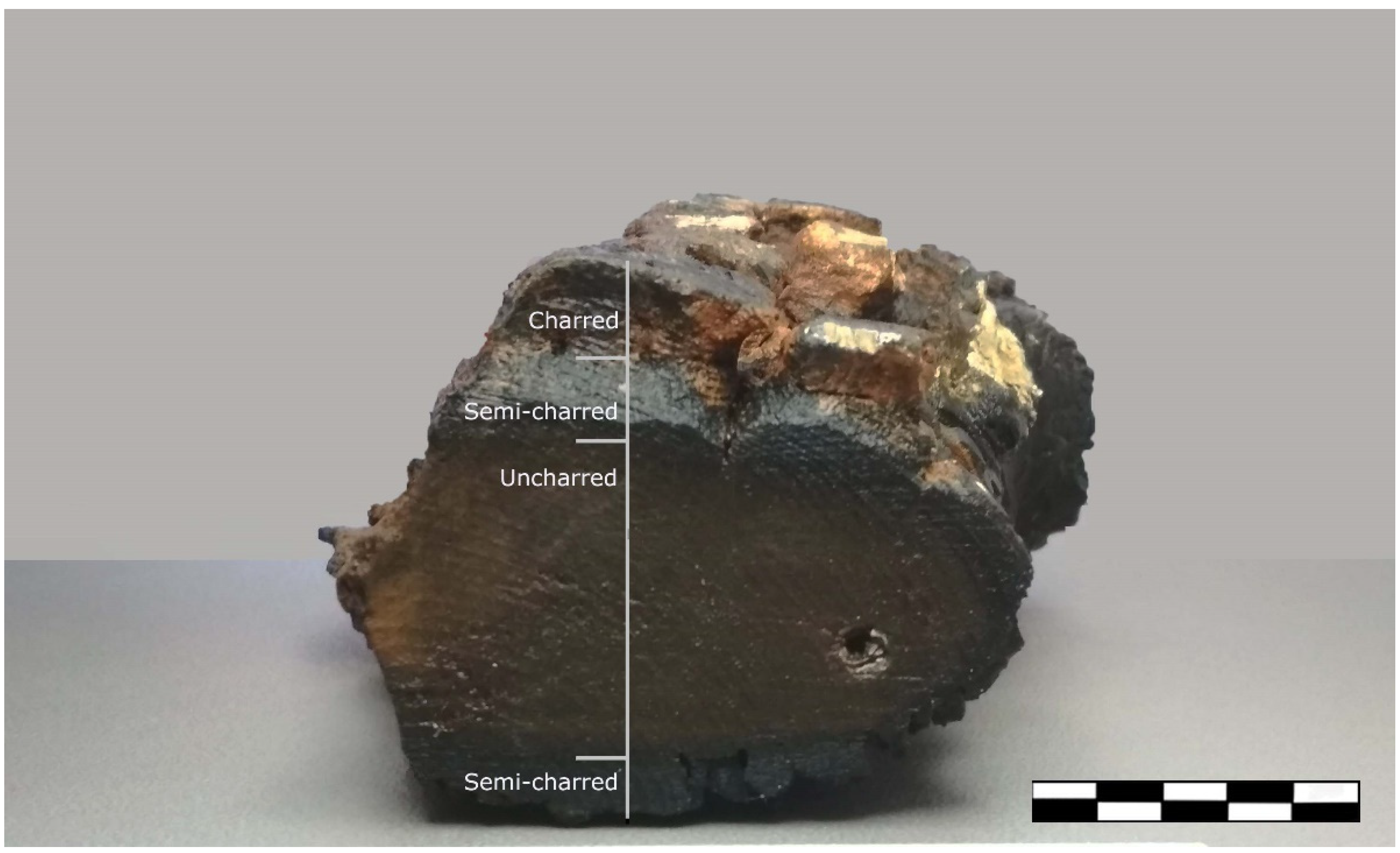

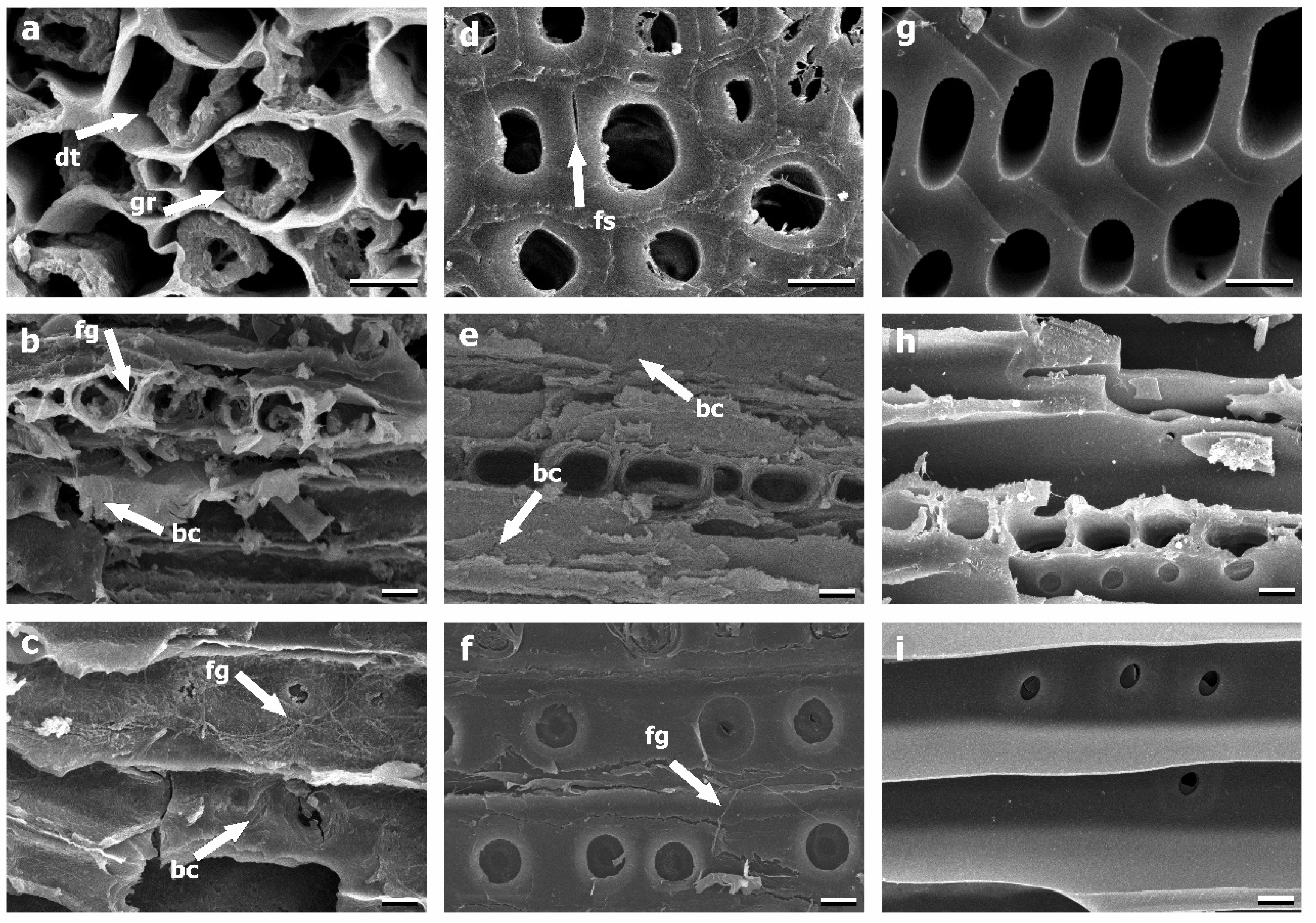
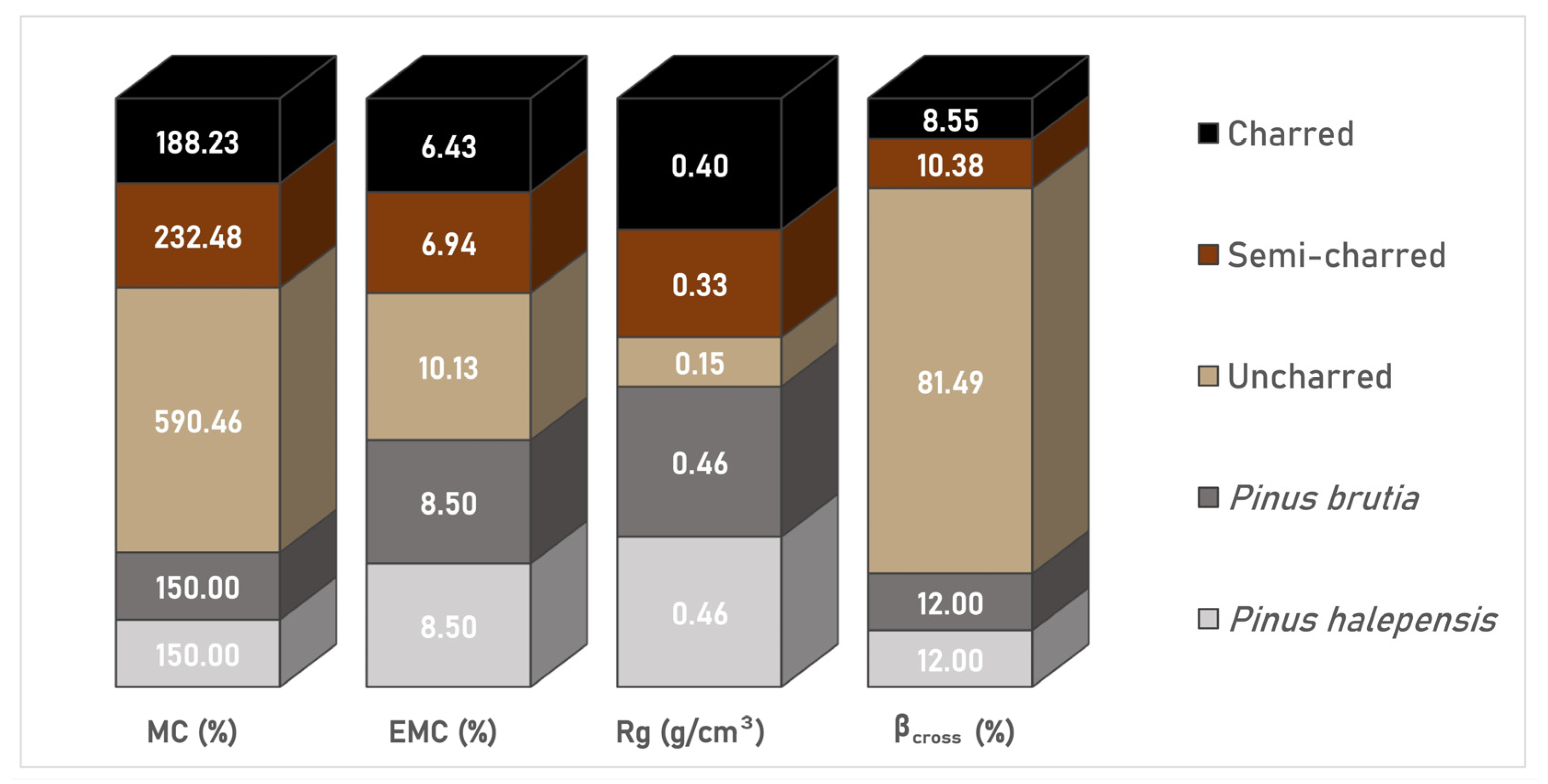

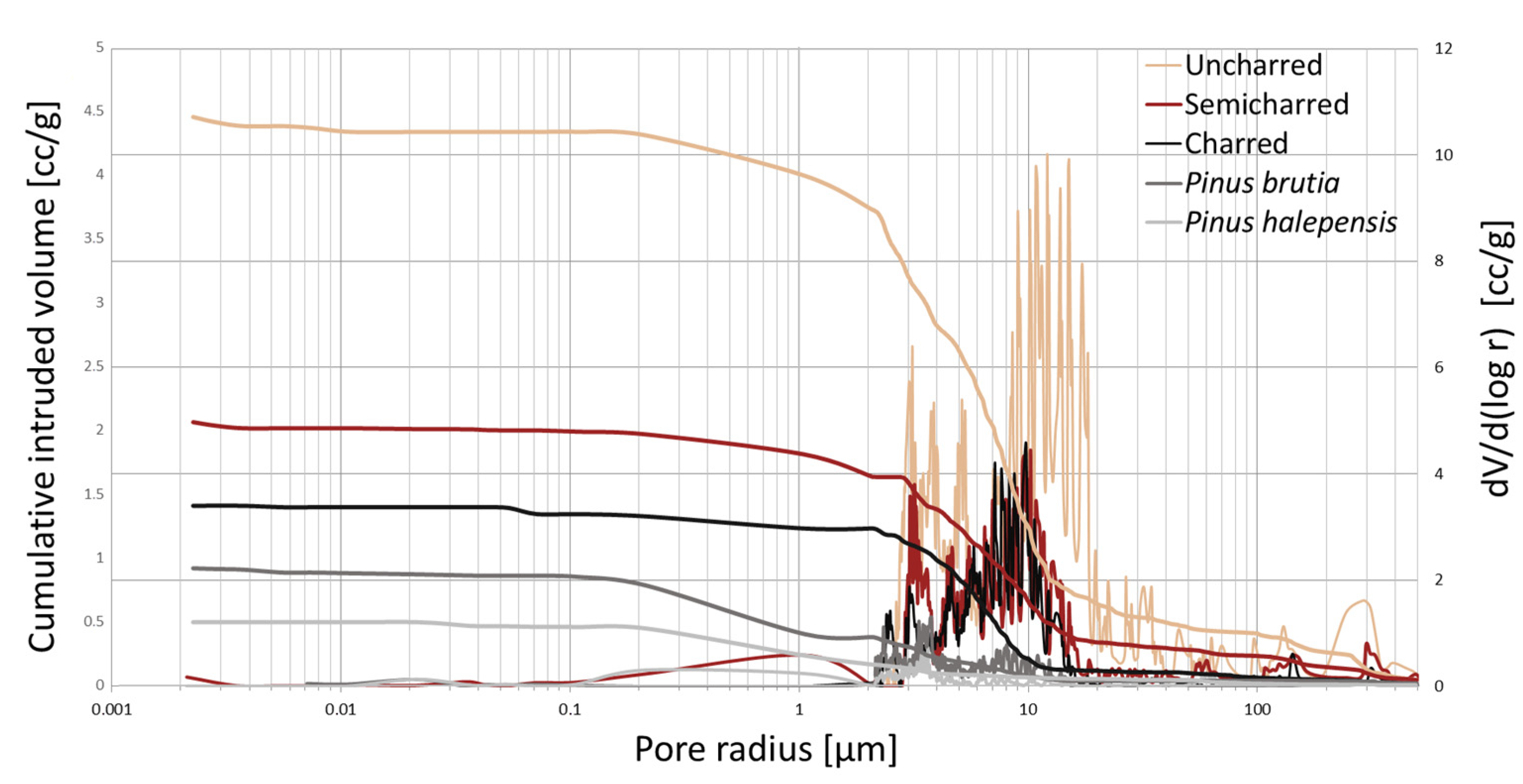
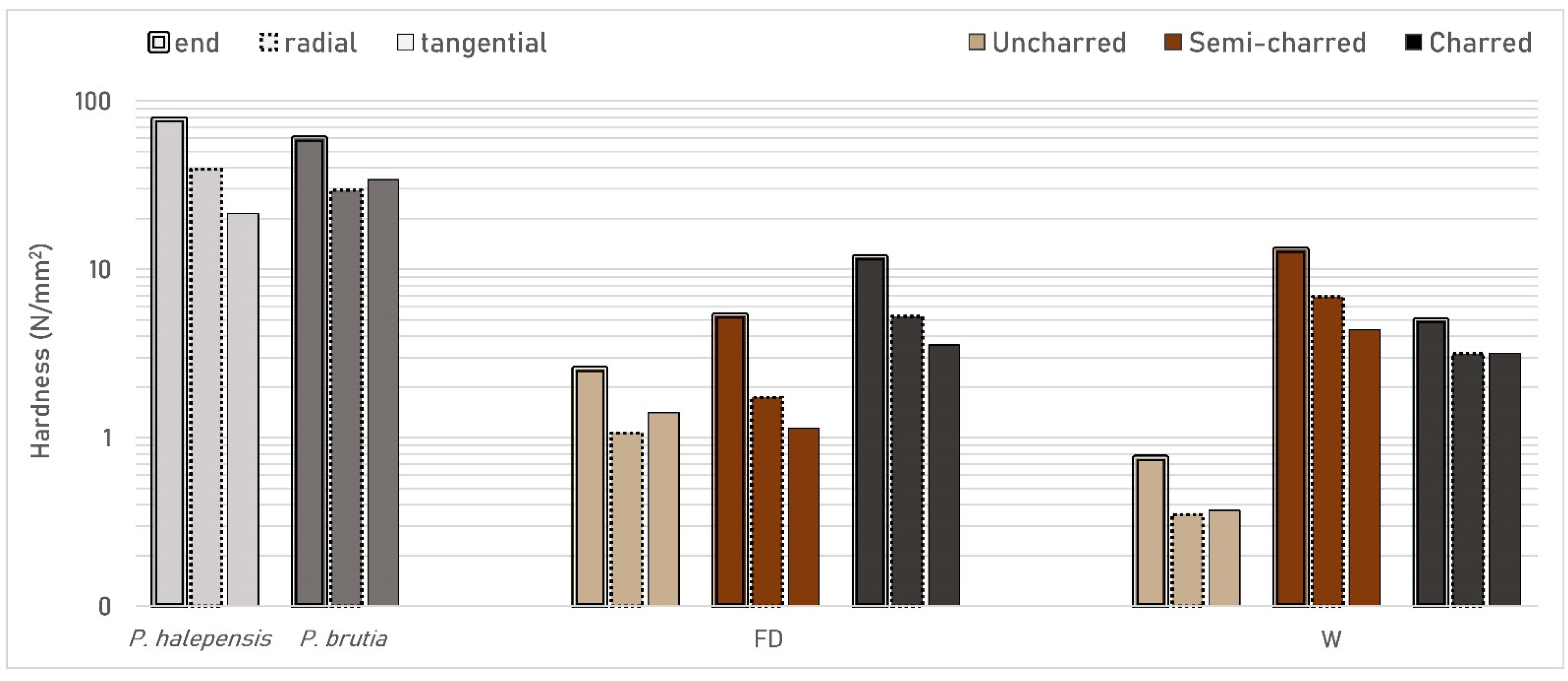

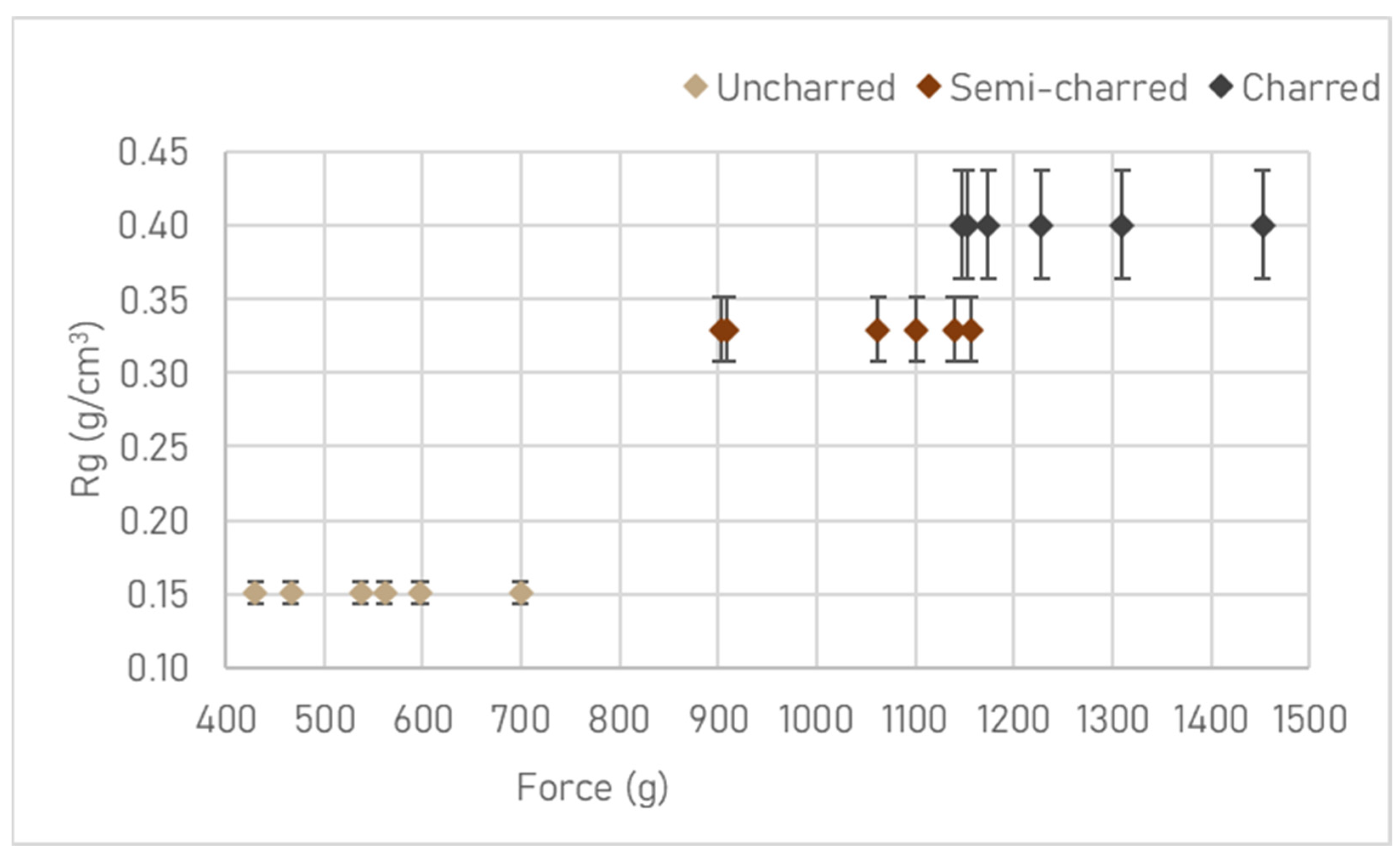
| Samples | MC (%) | EMC (%) | rRg | Rg (g/cm3) | βcross (%) |
|---|---|---|---|---|---|
| Uncharred | 590.46 (±28.33) | 10.13 (±0.58) | 0.19 (±0.02) | 0.15 (±0.01) | 81.49 (±0.15) |
| Semi-charred | 232.48 (±20.58) | 6.94 (±1.88) | 0.31 (±0.02) | 0.33 (±0.02) | 10.38 (±0.33) |
| Charred | 188.23 (±24.80) | 6.43 (±0.47) | 0.38 (±0.02) | 0.40 (±0.04) | 8.55 (±0.40) |
| Pinus brutia | 150.00 a | 8.00–9.00 b | - | 0.46 c | 12.00 d |
| Pinus halepensis | 150.00 a | 8.00–9.00 b | - | 0.46 c | 12.00 d |
| Hardness (N/mm2) | End | Radial | Tangential | |
|---|---|---|---|---|
| Pinus halepensis | 77.68 (±21.02) | 39.33 (±17.10) | 21.43 (±6.59) | |
| Pinus brutia | 59.76 (±26.02) | 29.53 (±16.32) | 34.09 (±16.00) | |
| Uncharred | FD | 2.57 (±0.87) | 1.07 (±0.26) | 1.41 (±0.07) |
| W | 0.76 (±0.18) | 0.35 (±0.02) | 0.37 (±0.00) | |
| Semi-charred | FD | 5.32 (±1.02) | 1.73 (±0.13) | 1.14 (±0.20) |
| W | 13.06 (±3.18) | 6.86 (±4.09) | 4.37 (±0.04) | |
| Charred | FD | 11.76 * | 5.25 (±1.44) | 3.55 (±0.01) |
| W | 4.98 (±3.46) | 3.16 (±1.15) | 3.17 (±1.07) |
Disclaimer/Publisher’s Note: The statements, opinions and data contained in all publications are solely those of the individual author(s) and contributor(s) and not of MDPI and/or the editor(s). MDPI and/or the editor(s) disclaim responsibility for any injury to people or property resulting from any ideas, methods, instructions or products referred to in the content. |
© 2023 by the authors. Licensee MDPI, Basel, Switzerland. This article is an open access article distributed under the terms and conditions of the Creative Commons Attribution (CC BY) license (https://creativecommons.org/licenses/by/4.0/).
Share and Cite
Mitsi, E.; Stefanis, N.-A.; Pournou, A. Physico-Mechanical Properties of Waterlogged Archaeological Wood: The Case of a Charred Medieval Shipwreck. Forests 2023, 14, 560. https://doi.org/10.3390/f14030560
Mitsi E, Stefanis N-A, Pournou A. Physico-Mechanical Properties of Waterlogged Archaeological Wood: The Case of a Charred Medieval Shipwreck. Forests. 2023; 14(3):560. https://doi.org/10.3390/f14030560
Chicago/Turabian StyleMitsi, Eirini, Nikolaos-Alexios Stefanis, and Anastasia Pournou. 2023. "Physico-Mechanical Properties of Waterlogged Archaeological Wood: The Case of a Charred Medieval Shipwreck" Forests 14, no. 3: 560. https://doi.org/10.3390/f14030560
APA StyleMitsi, E., Stefanis, N.-A., & Pournou, A. (2023). Physico-Mechanical Properties of Waterlogged Archaeological Wood: The Case of a Charred Medieval Shipwreck. Forests, 14(3), 560. https://doi.org/10.3390/f14030560







